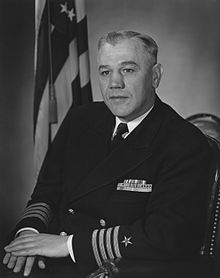Gerald L. Ketchum
| Gerald L. Ketchum | |
|---|---|
 |
|
| Born | December 5, 1908 Bellingham, Washington |
| Died |
August 22, 1992 (aged 83) Plano, Texas |
| Allegiance | United States of America |
| Service/branch | Navy |
| Rank | Rear Admiral |
| Awards | Legion of Merit, Silver Star |
Rear Admiral Gerald L. Ketchum (5 December 1908 – 22 August 1992) was a career officer in the United States Navy. He served during World War II and the Korean War. He was a recipient of the Silver Star and also participated in four expeditions to Antarctica.
Gerald Lyle Ketchum was born in Bellingham, Washington on December 5, 1908 and graduated from the United States Naval Academy in 1931.
During World War II Ketchum was a lieutenant commander and was placed in command of the destroyer USS Perkins (DD-377) on March 1, 1943. The Perkins was employed in operations in the waters off New Guinea.
On 22 September 1943, during an operation in which his ship was assigned to screen a convoy of landing craft, Ketchum and the Perkins engaged ten attacking Japanese torpedo planes. Ketchum positioned the Perkins between the planes and the convoy, and despite being heavily strafed, simultaneously avoided two torpedoes by skillful maneuvering, shot down one torpedo plane, and assisted in the destruction of another. For this action he was later awarded the Silver Star - the Navy's third highest award for heroism.
In the early morning hours of November 29, 1943, the Perkins was rammed by an Australian troopship and sank with the loss of nine American lives. Ketchum was held accountable for the incident by a board of inquiry and, unlike most naval officers whose ships have a collision under their command, he was allowed to command ships later in his career.
On December 28, 1946, Ketchum became the commanding officer of newly commissioned icebreaker USS Burton Island (AG-88). The Burton Island served in Task Group 68.2 during Operation Highjump, the United States Navy Antarctic Developments Program 1946–1947; also known as the Fourth Byrd Anatarctic Expedition. This was the Navy's first Antarctic expedition involving a large number of ships of various kinds and helped established the feasibility of sustained operations in the Antarctic.
...
Wikipedia
